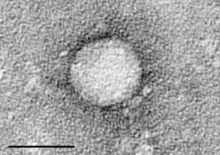Positive-sense single-stranded RNA virus
| Positive ssRNA Virus | |
|---|---|
 |
|
| Hepatitis C virus | |
| Virus classification | |
| Group: | Group IV ((+)ssRNA) |
| Order | |
A positive-sense single-stranded RNA virus (or (+)ssRNA virus) is a virus that uses positive sense, single-stranded RNA as its genetic material. Single stranded RNA viruses are classified as positive or negative depending on the sense or polarity of the RNA. The positive-sense viral RNA genome can also serve as messenger RNA and can be translated into protein in the host cell. Positive-sense ssRNA viruses belong to Group IV in the Baltimore classification. Positive-sense RNA viruses account for a large fraction of known viruses, including many pathogens such as the hepatitis C virus, West Nile virus, dengue virus, and SARS and MERS coronaviruses, as well as less clinically serious pathogens such as the rhinoviruses that cause the common cold.
Positive-sense ssRNA viruses have genetic material that can function both as a genome and as messenger RNA; it can be directly translated into protein in the host cell by host ribosomes. The first proteins to be expressed after infection serve genome replication functions; they recruit the positive-strand viral genome to viral replication complexes (VRCs) formed in association with intracellular membranes. VRCs contain proteins of both viral and host cell origin, and may be associated with the membranes of a variety of organelles, often the rough endoplasmic reticulum, but also including membranes derived from , vacuoles, the Golgi apparatus, chloroplasts, peroxisomes, plasma membranes, autophagosomal membranes, and novel cytoplasmic compartments. The replication of the positive-sense ssRNA genome proceeds through double-stranded RNA intermediates, and the purpose of replication in these membranous invaginations may be the avoidance of cellular response to the presence of dsRNA. In many cases subgenomic RNAs are also created during replication. After infection, the entirety of the host cell's translation machinery may be diverted to the production of viral proteins as a result of the very high affinity for ribosomes of the viral genome's internal ribosome entry site (IRES) elements; in some viruses, such as poliovirus and rhinoviruses, normal protein synthesis is further disrupted by viral proteases degrading components required to initiate translation of cellular mRNA.
...
Wikipedia
